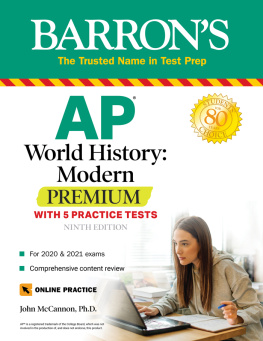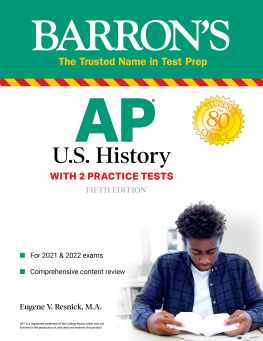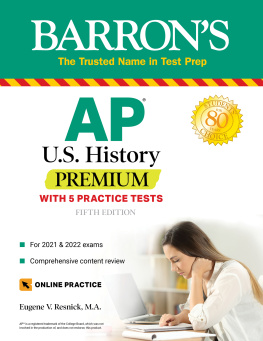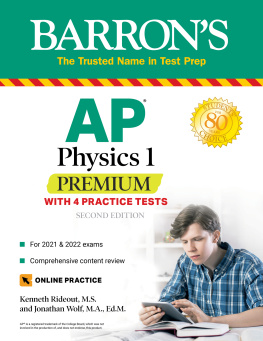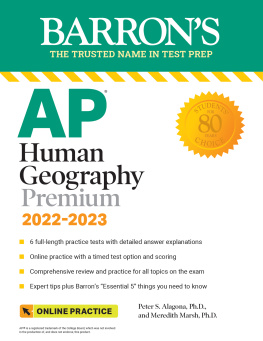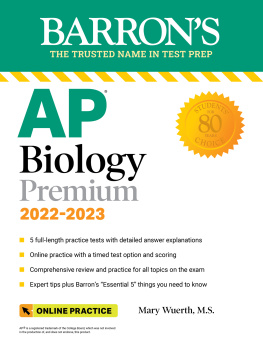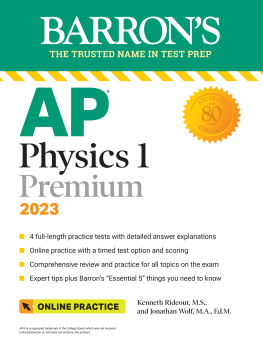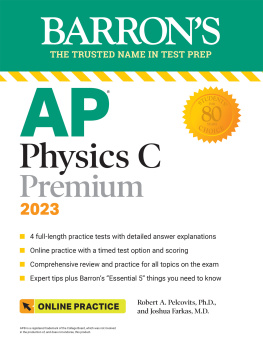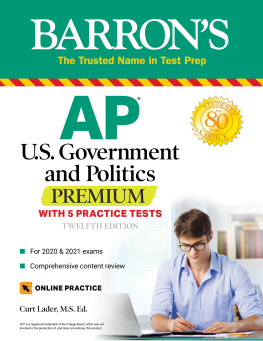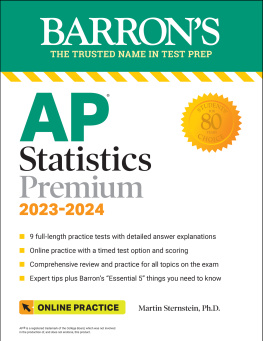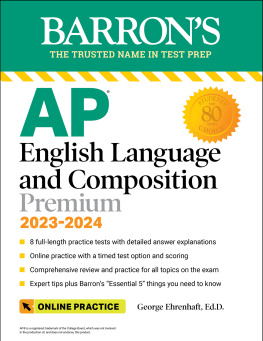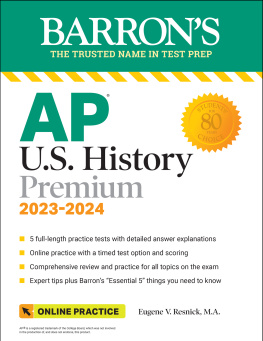Contents
Page List
BARRONS
AP
World History: Modern
PREMIUM
WITH 5 PRACTICE TESTS
NINTH EDITION
John McCannon, Ph.D.
Department of History
Southern New Hampshire University
Manchester, New Hampshire
AP is a registered trademark of the College Board, which was not involved in the production of, and does not endorse, this product.
About the Author
John McCannon earned a Ph.D. in history from the University of Chicago in 1994. He has taught Russian, European, and world history at several universities in the United States and Canada and is a former editor of the Canadian Journal of History. He has worked as an Advanced Placement Reader for the College Board and is the author of Red Arctic: Polar Exploration and the Myth of the North in the Soviet Union (1998) and A History of the Arctic: Nature, Exploration, and Exploitation (2012). He is currently an associate professor of history at Southern New Hampshire University.
About the Contributor
Pamela Jordan received a Ph.D. in political science from the University of Toronto in 1997. In addition to her academic background, she has worked as a news writer for Facts on File News Services, Inc., and as executive director of a nongovernmental organization affiliated with the United Nations. Dr. Jordan is the author of Defending Rights in Russia: Lawyers, the State and Legal Reform in the Post-Soviet Era and Stalins Singing Spy: The Life and Exile of Nadezhda Plevitskaya, and is also an assistant professor of political science at Southern New Hampshire University.
Acknowledgments
Both the author and contributor would like to thank Jennifer Giammusso, whose editorial supervision has made the preparation of this manuscripts various editions a smooth and successful process. We are also grateful to those assisting with art direction and production assistance and to the anonymous reviewers who have commented insightfully on this manuscript as it has evolved over the years. The author and contributor would also like to dedicate this book to their daughter Miranda, their favorite AP World History student.
Copyright 2020, 2018, 2016, 2014, 2012, 2010, 2008 by Kaplan, Inc.,
d/b/a Barrons Educational Series
All rights reserved under International and Pan-American Copyright Conventions. By payment of the required fees, you have been granted the non-exclusive, non-transferable right to access and read the text of this eBook on screen. No part of this text may be reproduced, transmitted, downloaded, decompiled, reverse engineered, or stored in or introduced into any information storage and retrieval system, in any form or by any means, whether electronic or mechanical, now known or hereinafter invented, without the express written permission of the publisher.
Published by Kaplan, Inc., d/b/a Barrons Educational Series
750 Third Avenue
New York, NY 10017
www.barronseduc.com
ISBN: 978-1-5062-7216-0
10 9 8 7 6 5 4 3 2 1
Contents
As you review the content in this book to work toward earning that on your AP World History: Modern exam, here are five essential points you should focus on. | Barrons
Essential | |
| Know the course themes. As important as factual knowledge is, you cant and wont be able to know every detail about the history of the world, nor will the exam focus on fact memorization. You need to think about how the facts fit into the wider contexts addressed by the themes. Not only will the multiple-choice questions be geared in this way, the essay questions will be theme-inspired. As a reminder, the official course themes are: interaction between humans and the environment development and interaction of cultures state building, expansion, and conflict creation, expansion, and interaction of economic systems and development and transformation of social structures. |
| Understand historiography. Historiography, the study of how historians think and write about history, is a topic of importance. What topics do historians choose to focus on? What sources and documents do they use as evidence, and how do they evaluate the strengths, weaknesses, and biases of that evidence? How do historians determine what causes a major event or development? How do they contextualize specific events and trends more broadly? A number of multiple-choice questions will ask you to analyze images, quotations, and excerpts from historical writing. The document-based question (DBQ) is designed expressly to make you think like a historian. |
| Remember your rubrics. The best-written and most insightful essays in the world will score poorly if they do not follow the rules. AP readers follow the rubrics closely as they assess papers, and following directions matters. Understand where your points come from and how to earn them. Focus particularly on crafting good thesis statements and presenting evidence effectively. |
| How and why (and how are they alike?) are more important than who and when. Names, dates, and other such details are never unimportant in the study of history. Mastery of facts can earn you extra points on essay questions and increase your chances of answering multiple-choice questions correctly. However, the exam is far more likely to emphasize how things were done, or why they happened, rather than who did them or when. Causes and effects matter greatly as well. Also, as you study any topic, always consider how it compares with similar topics in other times and places. |
| Focus on interactions. Note the number of times the word interaction appears in the course themes and historical periods. This is a topic of major interest, and you should concentrate on it throughout your studies. Note that interaction can take place on several levelslocal, regional, interregional, and globaland in many forms. |
INTRODUCTION
How to Use This Book
TO TEACHERS AND STUDENTS
This book can be used in one of two ways. For those taking (or teaching) a course in world history, or for those who have recently taken such a course, it can serve as a helpful supplement to coursework. For readers who are not taking, or have never taken, a course in world history, this book can serve as an independent study aid.
This introductory unit offers strategies for the various question types encountered on the AP World History: Modern exam. These will include multiple-choice questions and several questions requiring written answers: short-answer questions, a document-based question (DBQ), and a long essay question.
, is included to acquaint readers with concepts and context from earlier eras that will help make sense of the core material. Each of the main units is divided into Short Cut and Scenic Route sections. The Short Cut sections should suffice for those readers who need (or only have time for!) a quick review. The Scenic Route sections allow readers to explore topics in more detail, should they so desire.
The final section of the book contains two full-length practice tests. In addition, you can get even more practice, see the inside front cover of this book.
TO THE TEACHER
This books review chapters can be used to summarize or reinforce particular classroom or homework assignments. The Short Cut sections, with their unit overviews, allow students to examine historical events from a broad perspective. They are based on the course frameworks major themes, and they also place events and developments in the comparative context that the AP curriculum emphasizes.

